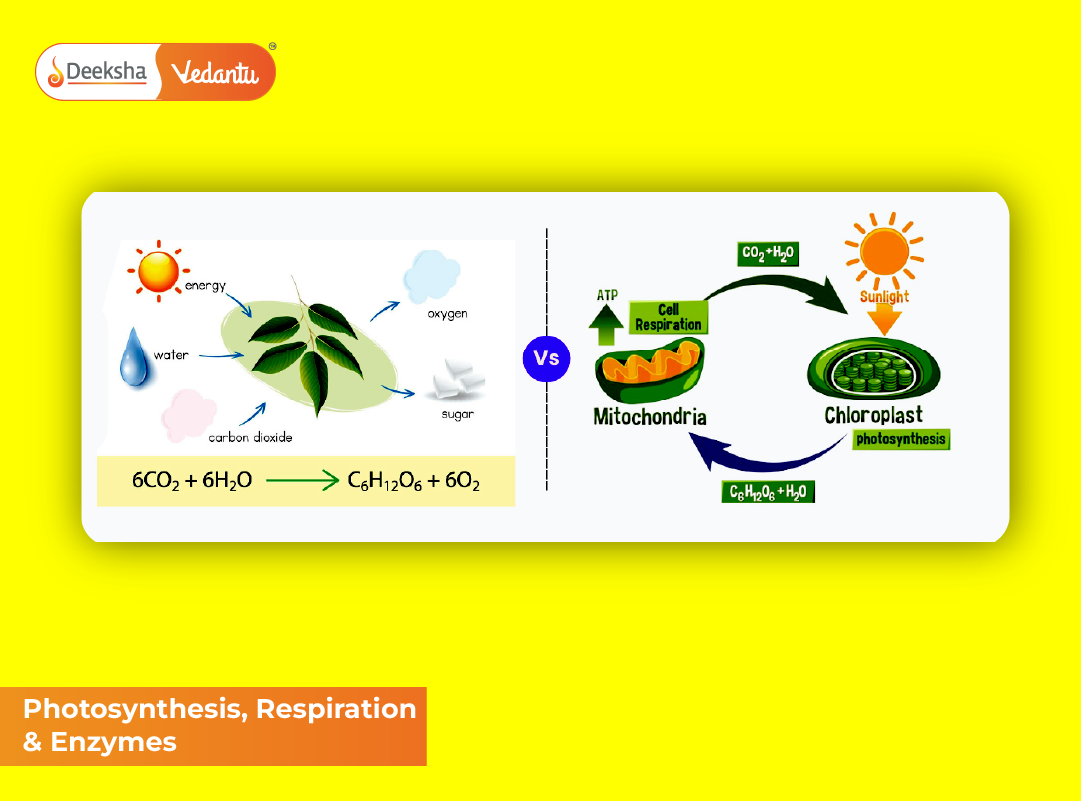Introduction
Life on Earth is a continuous dance of energy transformation. Every living organism—from the tiniest bacterium in the soil to the tallest tree in a forest—requires energy to sustain itself. This energy fuels cellular functions, movement, growth, repair, and reproduction. The two key processes responsible for this energy exchange are photosynthesis and respiration. These two complement each other perfectly: photosynthesis captures and stores energy from sunlight, while respiration releases that energy in a usable form. Standing at the center of both are enzymes, biological catalysts that make life’s chemical reactions happen at incredible speed and precision.
To understand how organisms acquire and use energy, it’s essential to first learn about these processes and their interconnected roles in maintaining life. You can explore related topics such as Nutrition and Life Processes to see how all biological functions work together seamlessly.
Photosynthesis: The Process of Energy Capture
Photosynthesis is the fundamental process through which plants, algae, and some bacteria convert solar energy into chemical energy. It primarily occurs in the chloroplasts of plant cells, which contain the pigment chlorophyll—responsible for capturing light.
The Chemical Equation of Photosynthesis
6CO₂ + 6H₂O + Sunlight → C₆H₁₂O₆ + 6O₂
This equation summarizes the process by which carbon dioxide and water combine in the presence of sunlight to form glucose and oxygen. The glucose produced becomes an immediate source of energy or is stored as starch for later use.
Detailed Stages of Photosynthesis
- Light Absorption: Chlorophyll molecules in the chloroplast capture sunlight energy.
- Photolysis (Splitting of Water): Light energy splits water molecules into oxygen, protons, and electrons.
- Carbon Fixation (Calvin Cycle): The captured energy helps convert carbon dioxide into glucose.
- Energy Storage: The glucose produced stores the solar energy in chemical bonds, later used by plants and animals.
Why Photosynthesis Is Essential
- It forms the base of the food chain, providing energy for all organisms.
- Oxygen released supports respiration in animals and humans.
- It regulates atmospheric gases, maintaining a balance between oxygen and carbon dioxide.
- It helps sustain ecological stability and life on Earth.
Photosynthesis not only sustains plants but also indirectly supports all living beings that depend on plants for energy. The products of this process fuel the next major life function—respiration.
Respiration: The Energy Releasing Process
Respiration is the biochemical process by which organisms break down glucose and other organic molecules to release energy in the form of ATP (Adenosine Triphosphate). While photosynthesis stores energy, respiration unlocks it for daily use. This process happens in the mitochondria, often referred to as the “powerhouse of the cell.” Learn more about cellular power generation at Mitochondria.
The Equation of Respiration
C₆H₁₂O₆ + 6O₂ → 6CO₂ + 6H₂O + Energy (ATP)
This reaction occurs in all living organisms, both plants and animals, ensuring that cells receive a steady supply of energy for metabolic activities.
Types of Respiration
| Type | Description | Example |
| Aerobic Respiration | Occurs in the presence of oxygen; releases large amounts of ATP (38 molecules per glucose). | Humans, animals, plants |
| Anaerobic Respiration | Occurs without oxygen; produces less energy (2 ATP per glucose). | Yeast, certain bacteria |
Role of Respiration in Living Organisms
- Provides energy for cellular repair, growth, and division.
- Enables muscle contraction and nerve transmission in animals.
- Maintains homeostasis by regulating body temperature.
- Removes carbon dioxide and water, preventing toxic buildup.
- Supports all vital life processes from movement to reproduction.
Respiration can occur continuously, unlike photosynthesis which depends on sunlight. For a detailed explanation, see Respiration.
Enzymes: The Catalysts of Life
Enzymes are proteins that accelerate biochemical reactions within living organisms. Without enzymes, life’s chemical reactions would occur too slowly to sustain biological activity. Enzymes control every reaction—whether it’s breaking down food, producing energy, or synthesizing new molecules.
Properties and Characteristics of Enzymes
- Specificity: Each enzyme is highly specific to its substrate (the molecule it acts upon).
- Temperature Sensitivity: Most enzymes work best at body temperature (around 37°C in humans).
- pH Dependence: Enzyme activity changes with acidity or alkalinity of the environment.
- Reusability: Enzymes remain unchanged after reactions and can be reused.
- Biological Origin: Enzymes are made by living cells and function under mild conditions of temperature and pressure.
Common Enzymes and Their Functions
| Enzyme | Function | Site of Action |
| Amylase | Converts starch into maltose (sugar). | Saliva, pancreas |
| Pepsin | Breaks down proteins into peptides. | Stomach |
| Lipase | Splits fats into fatty acids and glycerol. | Intestine |
| Catalase | Decomposes hydrogen peroxide into water and oxygen. | Liver cells |
| Rubisco | Helps fix carbon dioxide in photosynthesis. | Chloroplasts |
To explore more about enzymes and their role in metabolism, visit Enzymes in Biology.
Interconnection Between Photosynthesis, Respiration, and Enzymes
These three biological systems are not isolated—they form a continuous energy cycle. Photosynthesis and respiration complement each other, and enzymes ensure they occur efficiently.
- Photosynthesis captures sunlight energy and stores it as glucose.
- Respiration uses glucose to release usable energy in the form of ATP.
- Enzymes catalyze all intermediate steps, ensuring the process is rapid and controlled.
- Oxygen produced during photosynthesis is used in respiration, while carbon dioxide produced in respiration is used in photosynthesis.
This elegant balance maintains the Earth’s ecological and atmospheric stability, sustaining every form of life.
Comparison Between Photosynthesis and Respiration
| Aspect | Photosynthesis | Respiration |
| Location | Chloroplasts | Mitochondria |
| Energy Flow | Converts light energy into chemical energy | Converts chemical energy into ATP |
| Gas Exchange | Absorbs CO₂, releases O₂ | Absorbs O₂, releases CO₂ |
| Occurrence | Only in green plants and algae | In all living organisms |
| Dependency on Light | Requires sunlight (daytime) | Occurs both day and night |
| End Products | Glucose and Oxygen | Carbon dioxide, Water, and ATP |
Real-World Applications and Examples
- In Agriculture: Understanding photosynthesis helps farmers optimize crop yield through light, water, and nutrient management.
- In Medicine: Enzymes are used in diagnostic tests (like blood glucose testing) and treatments.
- In Industry: Enzymes are used in detergents, fermentation, and food processing.
- In Environment: Respiration and photosynthesis maintain atmospheric balance, reducing carbon buildup and supporting sustainability.
FAQs
Q1. What is the photosynthesis process?
Photosynthesis is the method by which plants make their own food using sunlight, carbon dioxide, and water. It produces glucose (energy source) and oxygen, which are vital for life.
Q2. How does respiration differ in plants and animals?
In both plants and animals, respiration breaks down glucose to release energy. Plants use some glucose they make during photosynthesis, while animals depend on food for glucose.
Q3. What are enzymes in biology?
Enzymes are protein-based catalysts that speed up chemical reactions necessary for digestion, energy production, and overall metabolism.
Q4. What are the key functions of enzymes?
Enzymes help in digestion (breaking down food), respiration (energy release), synthesis of biomolecules, and detoxification processes within cells.
Q5. Why are photosynthesis and respiration interdependent?
The oxygen generated by photosynthesis is used for respiration, while carbon dioxide from respiration is used by plants in photosynthesis—creating a balanced biological cycle.
Conclusion
Photosynthesis, respiration, and enzymes represent the core processes that sustain life. Through photosynthesis, energy is captured; through respiration, it’s released for biological work; and through enzymes, these processes occur with precision and efficiency. Together, they create a continuous energy cycle that supports ecosystems, maintains atmospheric stability, and enables life in all its complexity. Understanding these interactions helps us appreciate the incredible biochemical harmony that defines our planet.
Table of Contents










Get Social